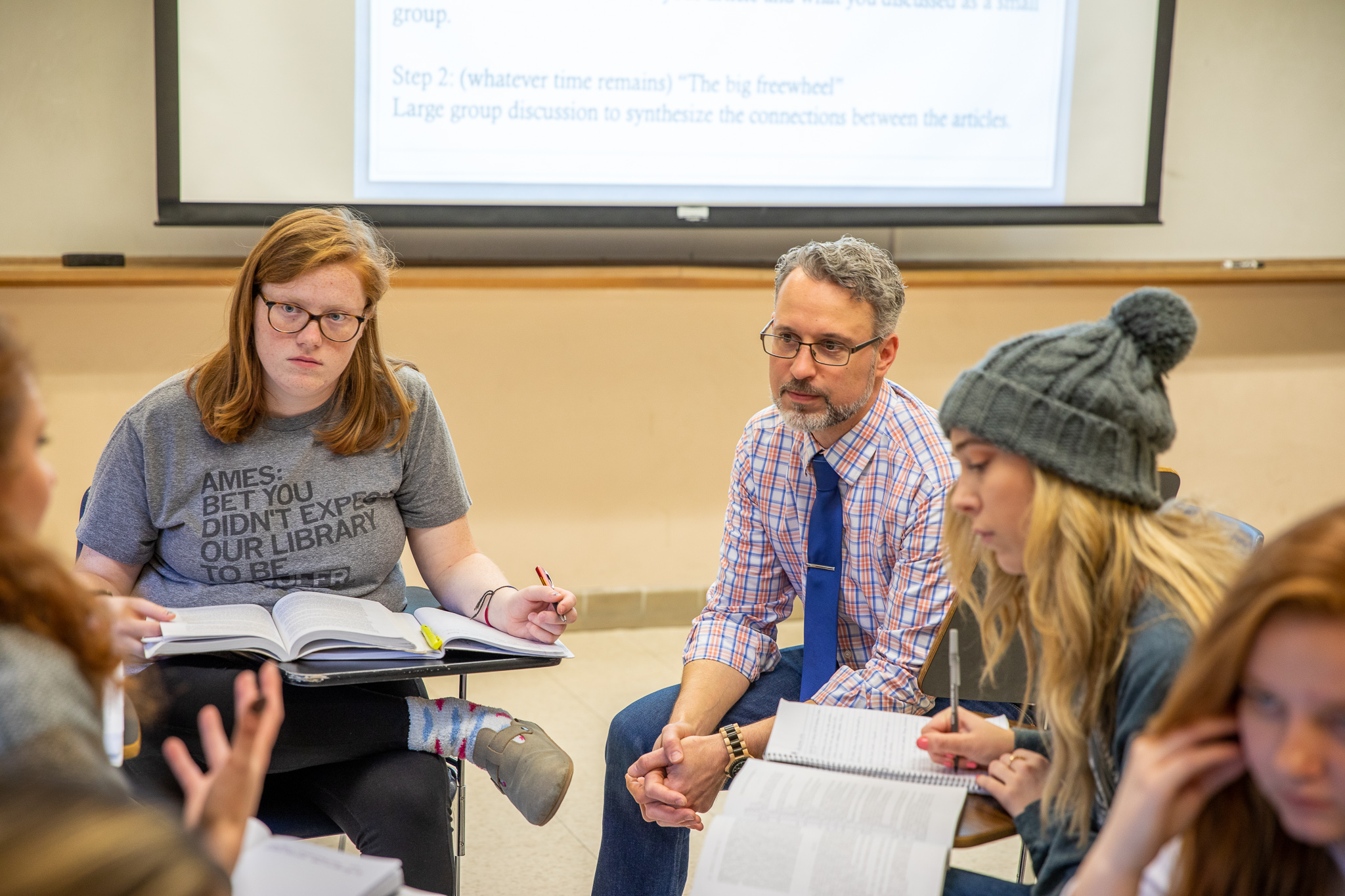Class about gender-influenced consumerism applies to multiple majors


Targeted marketing tactics and easy access to internet advertisements on their parents’ smartphones, tablets and computers give today’s preschoolers the ability to recognize and show preference for dozens of brands and logos. Those brands go beyond the child-focused companies of Disney, Mattel and Barbie. These kids, who are more than a decade away from driving, also quickly connect with logos for Toyota and Shell Gasoline.
This is just one of the enlightening facts that Michael Goebel, assistant teaching professor in women’s and gender studies and sociology, shares with students in “Gender and Consumer Culture” (WGS 430), a women’s and gender studies class that dissects the way consumer culture is shaped and changes, and how marketing and advertising campaigns strategically use gender to compel consumers to purchase certain products and services.
“A lot of times students say things like, ‘Oh, you’re reading too much into that ad.’” But a room of people have designed an advertisement, and there is not a single thing left to chance,” Goebel said. “To be able to get students to see that connection is really powerful.”
Eye-opening assignments
Goebel opens his students’ eyes to the world of consumerism by asking them, in part, to read scholarly articles, compare and contrast historical and modern advertisements, and study the classic, cultural dichotomy that portrays men as producers and women as consumers.
One unit focuses on “princess culture,” the idea that little girls — through movies, media and advertisements — expect their lives to emulate those of the princesses they watch on the big screen. A case in point is today’s fanfare surrounding high school proms and weddings.
“The training wheels of the princess culture is prom, and then it eventually becomes an extraordinary wedding,” Goebel said. “There’s this idea that there are elements that one has to have — the limo, the dress, the ‘promposal’ — in order to be seen as having had a proper prom experience, which sets them up for what follows.”
The class also takes a historical look at the “bachelor pad” concept, which Goebel explains is linked to the perception that single men became overt consumers in the early 1950s, thanks to the influences of magazines like Esquire and Playboy. Goebel says editorial content and advertisements in these male-focused publications gave men permission to outfit their homes in a sophisticated manner to attract and entertain an array of women, objectifying females in yet another way.
“The bachelor ethic created in these magazines and the permission it gave men to spend lavishly was revolutionary in the 1950s, particularly since it pushed back against the Protestant work ethic,” Goebel said.
Many majors
While most students in the class are women’s and gender studies majors and minors, students in other disciplines also find the study of gendered consumerism applicable to their programs. This semester, Goebel is teaching undergrad students in both marketing and advertising as well as graduate students studying business and history.
He says this topic can be taken in a lot of different directions. A business major, for example, can offer a stronger economics perspective while a history major can reference how women were the focus of food advertisements in the 1950s. Psychology students also would appreciate the class, he said.
“There’s psychology at play, advertising at play, history at play so it works across all those disciplines,” Goebel said. “It’s never about looking at one thing. It’s about situating things in a larger, cultural matrix – how does one product or advertisement, for example, fit and connect with other things, like cultural norms or economic shifts? That’s why I think this class works for a lot of different students.”
Megan Ziemann, a junior marketing major with minors in women’s and gender studies as well as French, is surprised at how well this class complements her business background.
“I’ve learned so much about sociological and psychological concepts like hegemony, fetishism and other aspects of a dominant culture,” she said. “I was expecting to look at a lot of old sexist ads, and while that is certainly a part of the class, I am learning bigger concepts that I can apply to other aspects of my education.”
Megan Lutz, a senior majoring in English and public relations with minors in technical communication and women’s and gender studies, also is learning concepts in this class she intends to use in her future career.
“What surprised me most about this class was realizing how often I’m being advertised to, and coming to terms with the different tactics of advertising, both historically and currently,” Lutz said. “I’ve learned a lot about what not to do when working in advertising.”
Cate Swan, a graduate student in history, is not overly surprised by what she has learned in the class so far, but she appreciates synthesizing concepts into a cohesive understanding of consumer culture.
“I’ve always been fairly skeptical of marketing, and the class has made that skepticism more pronounced,” Swan said. “I am definitely being more analytical about the media and the advertising that I see, taking more care to ask why something is being presented the way it is.”
Aside from understanding how consumerism affects gender, Goebel wants his students to walk away from this class with their eyes wide open, keenly aware of how advertisers are making them complicit in supporting and upholding larger systems of power and inequality.
“We can’t get outside of a consumer society, but we can be far more understanding of the way things work,” Goebel said. “It’s about opening their eyes, helping them see that there’s a lot more at stake than just pulling out their debit card and buying something.”